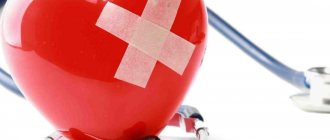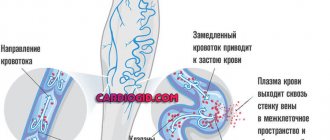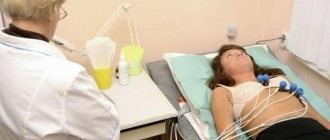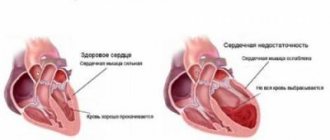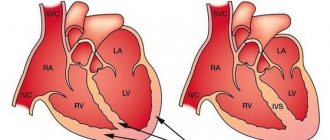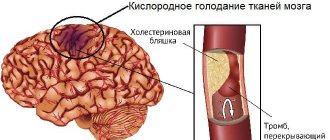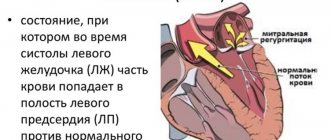What is acute cardiovascular failure (ACF)?
The inability of the heart to perform its functions normally indicates the development of HF syndrome. Its acute form is manifested by life-threatening conditions and is one of the most common causes of death.
In acute failure (AF), the functionality of one or both ventricles and atria may be impaired. Based on the location of the dysfunction, failure of the left and right parts of the myocardium is distinguished.
OSN proceeds:
- with symptoms of blood stagnation;
- with a sharp weakening of the ability to contract the myocardium (cardiogenic shock);
- as a worsening of chronic heart failure.
Cardiogenic shock can develop:
- as a reaction to pain (reflex);
- as a consequence of arrhythmia (arrhythmic);
- for large lesions due to infarction (true).
Various classifications separate cardiac and vascular failure. The term “acute cardiovascular failure” is used for a condition with a combination of both pathologies, united by a commonality of conditions, causes, mechanisms of their origin and development.
Cardiogenic shock is such a pathology. According to ICD-10, its code is R57.0: shock not classified elsewhere. Acute heart failure has code I50 in this classifier.
The pathogenesis and etiology of congestive-type AHF depends on the location.
Left ventricular
It is characterized by stagnation of blood in the pulmonary circulation (like the left atrium). AHF of the left ventricle appears in various diseases, especially often in heart disease. The most common complication is a heart attack.
Pulmonary edema often develops in left ventricular AHF. Pulmonary edema is a condition in which the lung tissue fills with fluid. Gas exchange is disrupted and the body experiences oxygen starvation. There are interstitial (cardiac asthma) and alveolar pulmonary edema. The latter is more dangerous and heavier.
Attacks of cardiac asthma torment the patient at night: there is a lack of air, suffocation, and a cough. With alveolar pulmonary edema, the symptoms are more severe, and their development is very rapid. Within a few minutes from the onset of the first signs of alveolar pulmonary edema, death can occur.
Left atrial
Acute congestive heart failure of the left atrium is also manifested by cardiac asthma and pulmonary edema. The most common cause of left atrial heart failure is mitral stenosis.
Right ventricular
OH of the right ventricle is associated with damage to the pulmonary artery. It manifests itself as a decrease in the contractile function of the right ventricle, impaired gas exchange, a sharp expansion of the heart and pulmonary artery, and stagnation in the systemic circulation.
Most often, this syndrome develops during acute blockage of a pulmonary artery by a thrombus.
What is cardiac muscle failure?
Our heart functions as a powerful pump. It is a muscle with several cavities. Blood accumulates in them. When contracting, this organ pushes blood out of the ventricles and atria, forcing it to flow through the elements of the circulatory system. Thus, the heart is a tireless engine, on the beating of which a person’s life depends.
Heart failure is diagnosed in cases where the biopump cannot fully perform its functions. It may not contract with sufficient force or may not fill with blood.
In such a situation, the heart is forced to take on increased load, trying to compensate for the defect that caused cardiac dysfunction. As a result, it quickly wears out, which leads to the development of serious complications.
Heart failure is a disease that can affect older adults, young people, and even young children. This disease significantly reduces the patient’s standard of living and poses a threat to life.
When our body's pump is dysfunctional, a lack of blood supply occurs. The inability of the heart to function fully leads to the fact that the tissues are no longer fully supplied with oxygen. Because of this, absolutely all organs and systems of the human body suffer.
You need to understand that dysfunction of the heart muscle is often not an independent disease. This pathology develops as a result of other diseases. In addition, it can lead to diseases of other internal organs.
Due to the danger of heart failure, at the slightest symptoms you should consult a doctor and begin treatment. Otherwise, both in old age and in young age, the outcome will be the same - death.
This is interesting! Signs of heart failure are more common in women than in men. Doctors attribute this to the fact that most often this disease occurs at an age to which not all representatives of the stronger half of humanity live.
Signs
In acute HF of the left side of the heart the following are observed:
- cough and wheezing in the lungs;
- discharge in the form of sputum with foam;
- difficulty breathing when lying down (orthopnea);
Acute right ventricular failure is characterized by:
- swelling of the veins in the neck;
- visually noticeable enlargement of the liver;
- yellowness of the skin;
- swelling;
- pain in the right hypochondrium;
- cyanosis of fingers, ears, nose.
When listening to the heart, the appearance of a characteristic tone is noticeable, the boundaries of the heart are expanded, and the heart rate is rapid.
How quickly does the problem develop?
Depending on how quickly the symptoms of heart failure increase, they speak of acute or chronic variants.
- Acute heart failure worsens over several hours or even minutes. It is preceded by various cardiac accidents: acute myocardial infarction, pulmonary embolism. In this case, the left or right ventricle of the heart may be involved in the pathological process.
- Chronic heart failure is the result of long-term illnesses. It progresses gradually and becomes more severe from minimal manifestations to severe multiple organ failure. It can develop in one of the blood circulation circles.
Symptomatic picture in women
Risk factors for heart failure in women differ from those in men. This is due to the later development of pathology in women, the characteristics of the female body, and its restructuring during menopause. The symptoms of the syndrome in women are generally the same as in men, but are more pronounced.
The risk of acute (and chronic) cardiovascular failure in women increases sharply if they suffer from diabetes or hypertension. Atrial fibrillation, one of the risk factors for AHF, is 1.5-2 times more common in women.
The adaptive capabilities of the body decrease with age. A woman’s health after the onset of menopause is subject to a double burden: age-related and associated with hormonal changes.
Symptoms of the disease
Heart disease is the most common cause of death in young and old populations. And the main problem lies in the fact that patients usually go to the doctor when the pathology is at advanced stages of its development. This is due to fear of medical institutions and simply ignorance of the symptoms of heart failure in women and men.
Manifestations of heart failure are quite typical. From them, even the uninitiated will be able to understand that not everything is in order with their heart.
How does heart failure manifest?
- Shortness of breath in heart failure is the most characteristic symptom. This symptom occurs due to stagnation in the elements of the circulatory system and low cardiac output. Shortness of breath usually occurs with increased physical activity. If treatment is ignored for a long time, this unpleasant phenomenon can occur even at rest.
Dyspnea - Cough due to heart failure. In this case, the discomfort is more pronounced in the lying position, and in the sitting position the patient experiences relief.
- Cardiac asthma. During sleep, patients may experience breathing problems, accompanied by severe shortness of breath. The reason for its development is the penetration of fluid from swollen extremities into the bloodstream.
- Confusion and memory impairment, sleep disturbance and depression. This occurs due to insufficient blood supply to the brain.
- Diuresis worsens during the day and improves at night. This is due to insufficient blood supply to the kidneys. At the same time, at night the blood flow slightly increases its intensity.
- Due to reduced diuresis and poor functioning of the kidneys, as well as impaired water-salt metabolism, fluid begins to accumulate in the body. Because of this, swelling forms. And most often the lower extremities swell. In severe cases, fluid may accumulate in the abdominal area.
- Discomfort in the chest area. In this case, often the most pronounced pain is present in the right hypochondrium due to excess blood supply to the liver. Because of this, the liver can increase significantly in size.
- With heart failure, there are always problems with blood pressure. In this condition, both hypertension and hypotension can develop.
- Congestion in internal organs. Heart failure has a negative impact on all body systems. This occurs due to poor circulation. In this case, the lungs and liver are the first to suffer. Therefore, patients with CHF often encounter chronic bronchitis and the formation of fibrous tissue in the liver.
- Paleness of the skin. This symptom is also caused by poor circulation. In the area of the labial fold, as well as on the extremities, cyanosis may be observed.
- In severe cases, cardiopulmonary failure may occur. In this case, hemoptysis will occur.
Symptoms before death
1-2 weeks before death, many patients developed typical symptoms:
- heartache;
- dyspnea;
- arrhythmia;
- weakness;
- fear of death.
Immediate referral to a cardiologist can often (and does) prevent death.
Before death during an attack, symptoms are usually observed:
- fainting due to ventricular fibrillation;
- convulsions;
- paleness and coldness of the skin;
- dilated pupils;
- convulsive breathing;
- During auscultation, a pendulum-like heart rhythm is heard.
From the onset of an attack to cardiac arrest, such signs can be observed for up to 2 hours.
Types of Heart Failure
The disease can also be divided into classes depending on the causes of its origin. In total, there are three forms of heart failure on this basis.
Classification by causes:
- Myocardial heart failure. Develops when the functioning of the muscle tissue of the heart is impaired. That is, our body’s pump loses its ability to contract normally. In this case, changes affect both systole and diastole.
- Overload CHF. Develops due to excessive stress placed on the heart muscle. Occurs due to circulatory problems.
- Combined CHF. It occurs when the biological pump is overloaded and the myocardium ceases to function fully.
Causes of the disease
HF of the left ventricle of the myocardium develops when:
- heart valve dysfunction;
- hypertension;
- cardiosclerosis;
- left ventricular infarction;
- cardiac aneurysm;
- ventricular hypertrophy.
These and some other diseases are accompanied by a high load on the left ventricle of the myocardium.
Most often, left atrial failure occurs when:
- mitral valve stenosis;
- thrombus in the atrium;
- atrial tumors.
Acute HF can be caused by cardiogenic or non-cardiogenic causes.
For the left ventricle and atrium, common non-cardiac causes of AHF are
- anemia;
- thyrotoxicosis;
- brain injuries and tumors.
Among the reasons leading to right ventricular failure:
- acute pneumonia, other lung diseases;
- right ventricular myocardial infarction, interventricular septum;
- aneurysm rupture;
- pericarditis;
- kidney diseases, liver diseases, tumors.
Progression of left ventricular AHF often leads to right ventricular AHF.
In addition to heart disease and non-cardiac factors, heart failure is also caused by other causes:
- alcohol abuse;
- smoking;
- non-compliance with diet;
- physical and mental overload;
- neglect of necessary treatment requirements;
- drug overdose;
- surgical intervention.
The combination of several causes increases the risk of developing acute heart failure syndrome.
Why does the disease develop?
There are many causes of acute heart failure. As mentioned above, this disease rarely occurs on its own. Usually it develops from other, no less serious pathologies.
Heart failure is a multicausal disease. The pathogenesis of this disease can be different.
Usually this pathology is a consequence of the lack or ineffectiveness of treatment for other pathologies. Dysfunction of the main muscle of the body develops if the biological pump, for some reason, is worn out. Also, some diseases can lead to cardiac dysfunction due to changes in its parameters or due to deterioration of blood flow due to negative changes in the vascular system.
Sometimes, prolonged exposure to negative external factors can lead to the development of heart problems. In this case, other pathologies develop, which, in fact, cause disruption of the functioning of the heart.
Internal pathologies
As mentioned above, there are many pathologies that can lead to disruption of the heart. The list shows the most common of them.
- Heart attack. In the post-infarction state, cardiac dysfunction often develops. It usually occurs due to thickening of the myocardium and rupture of the heart walls.
- Myocardium, endocardium and pericardium. These inflammatory diseases of the heart lead to the fact that the heart cannot contract fully, is poorly filled with blood, or the passages between the cavities of this muscle do not allow enough blood to pass through.
- Obstructive pulmonary diseases.
- Endocrine pathologies. Diabetes mellitus, thyroid and adrenal gland diseases are especially common causes of heart dysfunction.
- Arrhythmias of various types. Angina, bradycardia, tachycardia, etc.
- Pathologies that interfere with normal blood flow. These may be stenoses of elements of the circulatory system, tumor formations that compress large arteries, thrombosis and hypertrophic cardiomyopathy.
- Insufficiency of the mitral and aortic valves. In this case, they do not close tightly, which is why the ventricles are poorly filled with blood.
- Pulmonary artery thromboembolism.
- Cardiac tamponade. We are talking about squeezing the motor of our body, due to which it cannot contract normally.
- Heart injuries. They can occur during surgery or an accident.
- Severe anemia.
- Thyrotoxicosis.
- Hypertension. Hypertension places a serious strain on the heart. First, this leads to a loss of elasticity of its walls, and then to a loss of the ability to fully contract.
- Arteriovenous shunting.
- Ischemic heart pathology. This disrupts blood flow in the vessels that supply the heart muscle. Because of this, the functioning of this organ deteriorates.
- Congenital and acquired heart defects.
External factors
External influences can be a “trigger mechanism” for the development of heart failure. At the same time, they cause pathologies that lead to disruption of the functioning of the pump in our body.
What external factors can trigger the development of heart failure:
- Exhaustion of the body;
- Obesity;
- Lack of vitamins and minerals in the diet;
- Smoking;
- Alcoholism;
- Drug use;
- A large amount of fatty and unhealthy foods in the diet;
- Abuse of caffeinated drinks.
These are the external influences that can provoke the occurrence of most pathologies of the cardiovascular system and other organs. That's why it's so important to avoid them.
First aid
In case of acute cardiac and vascular failure, emergency assistance from specialists is always required. Before their arrival, first aid should be provided by people who were near the patient during an attack:
- Call an ambulance.
- Open the windows.
- Plant a person.
- Give the patient nitroglycerin: orally, sublingually, valocordin, corvalol.
- Place the patient's legs and arms in warm water, and sprinkle his face with cold water.
- Give ammonia to smell, do not allow loss of consciousness.
- Apply a tourniquet to the thigh, change its position every half hour.
- If there is no pulse, begin cardiac massage and artificial respiration.
- Place your hands on top of each other, palms down, at the bottom of your chest.
- Press evenly at a speed of 1 push per second on the patient’s chest, every 15 pushes perform mouth-to-mouth artificial respiration: 2-3 breaths, pinch the patient’s nose.
- After 2-3 repetitions of the previous point, the patient’s blood supply can begin to be restored. If there is no result, continue attempting resuscitation until the ambulance arrives.
Ambulance doctors take measures to stabilize the patient’s condition:
- Oxygen therapy is carried out.
- Painkillers, diuretics, bronchodilators, and vasodilators are administered intravenously, muscularly, orally.
- An ECG, blood tests, and, if technically possible, other diagnostic methods are performed: chest x-ray, echocardiography, MRI, CT.
- The patient is taken to the hospital.
Treatment of heart failure
How to treat heart failure? - This is the most popular question among people faced with this pathology. And the main thing that patients need to know is that they need to fight this disease not at home with the help of folk recipes, but as the doctor says.
Treatment of CHF is a long and complex process.
The doctor is faced with the task of not only eliminating the symptoms that bother the patient, but also curing the pathologies that provoked heart dysfunction.
What is the treatment of CHF aimed at:
- Minimize the risk of complications;
- Eliminate dangerous symptoms;
- Chest X-ray;
- Chest X-ray;
- Maximize the patient’s standard of living;
- Prevent exacerbation of the disease;
- Increase the patient's life expectancy.
Various methods are used for these purposes. This may be conservative treatment with medications or surgery. Sometimes these methods are combined.
Conservative treatment
Conservative treatment involves the use of drugs for heart failure. They are aimed at maintaining cardiac activity, normalizing blood pressure and preventing congestion in the body.
In most cases, it is tablets and other forms of heart failure medications that are used.
The surgical technique is used only in cases of extreme necessity. And even with surgery, drug treatment is usually included.
What medications are prescribed for heart failure:
- ACE blockers. This drug allows not only to normalize blood pressure, but also to prevent the progression of heart muscle dysfunction and prevent damage to the kidneys and blood vessels.
- Angiotensin-2 receptor inhibitors. The drug allows you to regulate blood pressure.
- Adrenergic blockers. The medicine regulates blood pressure, normalizes heart rate, and eliminates arrhythmia.
- Aldosterone prescription blockers. These medications have a diuretic effect and prevent potassium leaching. Used for congestive CHF.
- Diuretic medications. The drugs have a powerful diuretic effect. They have the ability to reduce blood pressure. Diuretics for heart failure are often combined with other medications.
- Cardiac glycosides. Medicines are used for atrial fibrillation.
- Esters of polyunsaturated acids. They have the ability to thin the blood and normalize fat metabolism.
- Statins. The agents prevent the deposition of atherosclerotic plaques in blood vessels.
- Indirect anticoagulants. Prevents the secretion of blood clotting factor. The risks of atrial fibrillation and thromboembolism are reduced.
- Nitrates. Normalize blood flow and dilate blood vessels.
- Calcium channel blockers. They fight angina pectoris, normalize blood pressure, and are effective in cases of heart muscle valve insufficiency.
- Antiarrhythmic medications. Helps with arrhythmia.
- Disaggregants. Prevents blood clotting. Used for heart failure due to chronic heart failure.
- Non-glycoside inotropic stimulants. Used for very low blood pressure and weakness of the heart muscle.
Surgical intervention
Surgery is used in cases where conservative treatment is ineffective. In this case, drug therapy can be used in parallel.
Surgical treatment of CHF:
- Setting up artificial pacemakers. This device creates an electrical impulse that is transmitted to the heart. Other prosthetic parts of the heart muscle can also be implanted.
- Coronary bypass surgery. This technique involves creating pathways for blood flow to the vessels of the heart. It is used if there are atherosclerotic plaques on the elements of the circulatory system.
- Surgical intervention in the valve system. It is used in cases of improper functioning of the heart valves and vascular stenosis.
- Heart muscle transplant. In this case, either a donor heart or an artificial one can be used. It is used when the native organ cannot be restored with the help of prostheses.
- Circulatory support devices. Additional artificial ventricles compensate for the insufficiency of the “native” cavities of the heart.
- Wrapping the heart muscle with a frame. Prevents an increase in the size of the heart muscle.
Diet therapy
Diet therapy plays an important role in the treatment of CHF. It helps prolong the patient’s life and avoid the development of complications.
Diet for heart failure:
- Minimize the amount of salt in your diet. This spice prevents the removal of fluid from the body, which can provoke the development of stagnation.
- Eat foods rich in magnesium. They are necessary for the full functioning of the heart.
- Include plenty of fresh vegetables and fruits in your diet. Green vegetables, pumpkin, sweet peppers, etc. are especially useful in this case. You should also give preference to berries and fruits with a diuretic effect.
- Avoid fatty foods. Animal fats are especially dangerous.
- Try to cook foods by boiling, stewing, baking and steaming. Avoid fried foods.
- Say no to processed foods and fast foods. The ban includes sausages, fatty salty cheeses, smoked meats, pickles, marinades and store-bought sauces.
- Fermented milk products are very useful. You can make delicious and healthy sauces from them.
- The lack of salt can be compensated for with natural herbs. This could be basil, coriander, rosemary, etc.
- Avoid alcohol.
- Include nuts and dried fruits in your diet. They will replace unhealthy snacks and desserts.
- Reduce the amount of sweets in your diet.
Diet therapy
Lifestyle with heart failure
To prevent exacerbation of chronic heart failure, you need to change your lifestyle.
Below are the main nuances of activity in this disease.
Lifestyle with heart failure:
- Refusal from physical activity is in most cases contraindicated in CNS. The degree of load is selected for each patient individually depending on the severity of the problem. At the same time, every patient needs to know that if there are problems with the functioning of the heart muscle, dynamic loads are indicated and static loads are prohibited.
- Rejection of bad habits. Avoiding smoking and drugs is an important condition for prolonging the life of patients with CNS. These habits negate all the results of even the most correct treatment.
- People suffering from heart failure problems should avoid traveling to high altitudes. Such conditions help reduce blood pressure and place increased stress on the heart muscle.
- You should avoid prolonged exposure to the sun, as well as in hot and stuffy rooms. Such conditions also contribute to putting excessive pressure on the heart.
- You should not stay in one position for a long time. If a given situation or work activity requires this, then it is necessary to warm up every half hour.
- Avoid swimming in water that is too cool or too hot. This can trigger an attack of heart failure.
- Stressful situations must be avoided. Emotional stress is the most common cause of complications from the cardiovascular system.
Is it curable or not?
Acute heart failure syndrome is always a complication of another disease. Even in the case when, before the onset of this syndrome, a person considered himself absolutely healthy, and recent examinations did not reveal any deviations in his state of health. There are a huge number of causes of acute heart failure. These are primarily diseases of the heart, blood vessels, lungs, and kidneys. Many of these diseases are asymptomatic, but at some point it becomes a crisis and AHF occurs.
Treatment of acute heart failure is, first of all, saving the patient’s life and bringing him out of a critical condition. But establishing the cause that led to AHF is also important and urgent, since such causes can be extremely serious diseases: heart attack, stroke. Elimination of heart failure syndrome is closely related to the treatment of the underlying disease and whether the disease is curable or not.
To improve the prognosis of not only AHF, but also the underlying disease that caused it, it is necessary to quickly diagnose and carry out adequate treatment measures, such as:
- Ultrasound of the heart;
- coronary angiography;
- myocardial revascularization;
- cardiac stimulation;
- pulmonary artery probing.
Death from acute heart failure can occur within 5-10 minutes.
2% of the population in developed countries suffer from heart failure. Therefore, any diagnostic measures to determine the likelihood of heart failure are very valuable.
Thus, recently Russian and German researchers proposed the use of tomography and capillaroscopy to determine circulatory disorders in patients with heart failure. Such an assessment allows you to determine the risk of edema, which means it will help prevent the occurrence of acute and worsening chronic heart failure.
When to see a doctor
Cardiovascular insufficiency is often detected at advanced stages of development. Therefore, in order to identify this problem in time, you need to know what signs indicate the need to see a doctor and undergo an examination.
Heart failure - briefly about the first symptoms:
- Deterioration in sleep quality;
- Increased fatigue;
- Sudden dizziness;
- Shortness of breath during physical activity;
- Swelling of the legs due to heart failure;
- Cough;
- Paleness of the skin.
It is also worth consulting a doctor if the patient notices that he feels most comfortable in a sitting position and for normal sleep he has to put several pillows under his head.
You can lie on a flat surface without a pillow and monitor your sensations; if you have difficulty breathing, then the risk of heart failure is very high.
Treatment
The goal of emergency treatment of acute heart failure carried out in a hospital is to stabilize hemodynamics and save life.
Drugs
First, determine the type of acute heart failure and the diagnosis of the underlying disease, known or simultaneously diagnosed, what drugs and measures will be carried out during treatment:
- oxygen therapy - to compensate for oxygen deficiency;
- intravenous administration of vasodilators, nitroglycerin or nitroprusside in the absence of hypotension;
- for better diuresis, loop diuretics are used - furosemide, torsemide - intravenously, by infusion;
- in case of insufficient filling pressure of the myocardial ventricles - intravenous fluid administration;
- to relieve stress and improve hemodynamics - intravenous morphine;
- digitalization for atrial fibrillation with fast-acting cardiac glycosides (digoxin, celanide);
- amiodarone - for drug cardioversion;
- in case of a severe attack of tachycardia, intravenous administration of adenosine;
- an adrenergic agonist is administered intravenously: dopamine, dobutamine, norepinephrine - a drug that improves metabolism in the heart muscle;
- aminophylline (aminophylline) is used intravenously in the treatment of pulmonary edema, to relieve bronchospasm;
- ACE inhibitors and beta-blockers are prescribed to prevent the recurrence of acute heart failure.
Only medical treatment with drugs for acute heart failure is not enough.
Ventricular fibrillation requires immediate electrical impulse therapy, hemodynamic instability requires emergency coronary angiography. Often, a venous catheter must be inserted to evaluate the condition of the heart. Mechanical methods of circulatory support are used while awaiting heart transplantation.
Symptoms of AHF may decrease and even disappear as a result of a successfully carried out set of measures, but in the future it is necessary to continue treatment and actions aimed at more accurately identifying the underlying disease.
Lifestyle and nutrition
Heart failure most often occurs as a complication of heart disease, so the basic recommendations for diet and lifestyle are the same as for many chronic cardiovascular diseases:
- to give up smoking;
- sharp restriction of alcohol;
- maintaining normal weight;
- physical activity without overload, but regular;
- proper nutrition with a predominance of fresh vegetables, fruits, lean meats, fish, seafood; refusal of fried, smoked, canned foods, baked goods; calorie restriction;
- salt and fluid restriction;
- elimination of emotional overload, stress;
- compliance with all medical instructions;
- regular visits to a cardiologist and therapist;
- positive attitude.
The last recommendation is especially difficult to implement, but absolutely necessary: depressive thoughts themselves shorten life.
Diagnosis of heart failure
The first thing a patient should do when faced with symptoms of heart failure is to consult a doctor. Of course, you can make an appointment with a therapist, who, after an initial examination, will send you to a more specialized specialist, but a cardiologist deals with problems of the cardiovascular system. Therefore, you can go straight to him.
Diagnosis of heart failure includes many stages. At the same time, a specialist will be able to suspect the presence of the disease after an initial examination of the patient, due to the specificity of the signs of cardiac dysfunction.
Tests and hardware examination are necessary to determine the area of damage, the degree of neglect and the type of disease. In this case, not only the heart is examined, but also other organs that may have been damaged by the disease.
Also, hardware diagnostics are necessary to determine the cause of the development of cardiac muscle dysfunction. After all, this disease does not develop on its own, but is a consequence of other pathologies.
At the doctor
As mentioned above, the initial examination in the case of cardiac dysfunction is of primary importance. This is where this disease is usually detected.
In addition, some tests can even help an experienced specialist identify the stage of the disease.
Heart failure - primary diagnosis:
- First of all, the doctor questions the patient about the presence of certain symptoms. It is important to report any discomfort. Heart failure may be indicated by pain in the heart, low blood pressure and other symptoms described.
- The patient's medical history is also examined. Chronic diseases that the patient has are of great importance. After all, they can be the cause of disruption of the functioning of the heart muscle.
- An important role is played by the analysis of the patient's life. His work activity, the presence of bad habits, as well as the use of certain medications can tell a lot about the state of his health.
- Family history. The doctor will also interview the patient about the presence of chronic diseases in his relatives. After all, many cardiovascular pathologies are inherited.
- The specialist must conduct a visual examination of the patient. He is interested in the color of the skin, the presence of swelling, and the size of the veins in the neck.
- Blood pressure measurement. Typically, patients with heart failure have abnormal blood pressure.
- Listening to the heart, pulse and lungs. The presence of arrhythmia, wheezing in the lungs, a weak pulse - all this may indicate insufficient cardiac function.
Examination by a cardiologist
Typically, the visual examination methods described are sufficient to determine whether a patient has heart failure. Further actions will be aimed at confirming the diagnosis and clarifying a number of nuances of the disease.
There is a special test to determine the stage of heart failure.
The patient is asked to walk for six minutes at a comfortable pace. Then they calculate how many meters he was able to walk during this time. Based on this, conclusions are drawn regarding the degree of neglect.
Functional classes of the disease according to the walking test:
- The norm is more than 550 m;
- First class – from 425 to 550 m;
- Second class – from 300 to 425 m;
- Third class – from 150 to 300 m;
- Fourth class – less than 150.
Taking tests
Diagnostic tests help to assess the condition of the body as accurately as possible. In addition, they can be used to check the functioning of the kidneys, liver and other organs.
Tests for CHF:
- General and biochemical analysis of blood and urine. This study of biological fluids helps to detect the presence of protein in the urine, check the amount of bilirubin in the blood, determine the concentration of aldosterone, urea, creatinine, glucose and uric acid. This will help check the condition of other organs.
- Blood test for thyroid hormones. It is with dysfunction of this organ that heart failure can develop.
- Immunological blood test. Using this analysis, it is possible to check the presence in the blood of special antibodies and proteins that arise during inflammation and damage to internal organs by microorganisms.
- Coagulogram. Allows you to check the level of blood clotting. This procedure also makes it possible to identify platelet breakdown products in the body that are absent in the biological fluids of a healthy person.
- Blood test for the presence of sodium uretic hormones. This analysis makes it possible to detect not only the presence of a pathology such as cardiac dysfunction, but also to determine its stage. In addition, such indicators make it possible to judge the effectiveness of treatment.
Blood test
These are the main studies that are prescribed for suspected heart failure in children and adults. If necessary, the doctor may prescribe additional tests.
Hardware examination
Previous diagnostic methods can usually accurately determine the presence of heart failure. To understand at what stage of development this disease is, in what area it is localized, which organs it has already affected, and what are the causes of its occurrence, a hardware examination is used.
Diagnostic equipment is selected based on previous studies. The list contains techniques that are used in most cases.
Hardware diagnostics of cardiac dysfunction:
- ECG. This is the very first study that is prescribed to patients with cardiac dysfunction. It helps determine how rhythmically the heart muscle contracts, identify problems with the heart rhythm, and even verify the size of the ventricles and atria, as well as the presence of scars on them.
- X-ray of the chest organs. Allows you to examine the condition of the lungs in detail, detecting stagnation of blood and fluid in them. Also, using this diagnostic method, you can evaluate the structure of the heart, identifying an increase and change in the structure of its parts.
- Ultrasound of the heart. Allows you to determine the thickness of the heart walls, as well as its size. It even makes it possible to check how this organ performs its contractile function and how its valves work.
- Doppler echocardiography. This technique makes it possible to check the patency of blood vessels. It is the best way to identify the presence of blood clots and sclerotic plaques.
- Transesophageal EcoCG. The sensor is placed in the esophagus. The diagnostic method allows you to better examine the condition of the heart. Most effective for thrombosis and atrial fibrillation.
- Stress echocardiography. The method involves studying heart parameters at rest and after physical activity. Necessary for assessing the viability and reserve capabilities of our body's pump.
- SKT. The technique involves taking a series of x-rays. Allows you to examine the heart in more detail. MRI is also used for these purposes.
- KKG. A dye is injected into the vessels of the heart. This allows you to determine the presence of blood clots and atherosclerotic plaques in it.
- Biopsy of heart tissue. In this case, an analysis of cells taken from all the membranes of the heart muscle is performed. Necessary for determining the presence of tumors, pus and other formations uncharacteristic for this organ.
Heart tissue biopsy
Examinations of other organs may also be performed. This allows us to identify the causes and consequences of CHF.
Consequences of edema
Superior vena cava syndrome
- mediastinal tumor (central cancer, lymphogranulomatosis),
- aortic aneurysm,
- adhesive pericarditis (rare). Very rare, but thrombosis of the superior vena cava is also possible.
- swelling (with swelling of the vocal cords there may be hoarseness, asphyxia), cyanosis,
dilatation and swelling of superficial veins.
All these symptoms are aggravated when lying down. Possible bleeding: nasal, esophageal, tracheal.
Venous pressure increases significantly.
It is important to diagnose the underlying disease that caused extravasal compression. In case of thrombosis, it is necessary to examine the hemostatic system. Cavagraphy is possible.
Inferior vena cava syndrome
- spread of thrombus from the veins of the lower extremities,
local thrombosis of different segments of the inferior vena cava,
developmental anomaly (usually the upper segment),
compression of the vein by a tumor or inflammatory infiltrate.
- lower, distal - before the renal veins flow into the inferior vena cava,
- average - from the confluence of the renal veins to the confluence of the hepatic veins and
- upper - from the level of the confluence of the hepatic veins to the right atrium.
With distal lesions, symptoms from the lower extremities and pelvic organs are observed. When the middle segment is affected, symptoms characteristic of renal vein thrombosis are added: oliguria, macro- and microhematuria, development of nephrotic syndrome, renal failure. When the upper segment is affected or with isolated thrombosis of the hepatic veins, the HSM-CHIA syndrome develops (Budd-Chiari, see 5.2.1.4).
The diagnosis is clarified using ultrasound, cavagraphy, and MRI.
The consequences of edema depend on the location, duration and severity. Edema of the lungs, larynx, and accumulation of edematous fluid in the cardiac membrane, pleural cavity, and brain cavities are very dangerous. Prolonged accumulation of fluid in tissues disrupts blood circulation, reduces the supply of nutrients to cells, causes compression, disrupts the structure and function of the damaged organ and those located nearby, and decreases resistance.
Pulmonary edema leads to asphyxia, hydrops of the pericardial cavity leads to cardiac tamponade, ascites disrupts the function of the abdominal organs.
Sometimes swelling performs a protective function. So, with inflammatory, toxic edema, edematous fluid reduces the concentration of toxic substances in the tissues.
Scheme 1
Edema appears due to disruption of the heart, but in advanced cases it can cause other diseases.
The most dangerous consequences:
- fluid accumulates not only in the legs, but throughout the body, affecting the hips, arms, neck, face;
- formation of ulcers in areas of swelling;
- accumulation of lymph in any anatomical area;
- pulmonary edema;
- accumulation of fluid in the peritoneum;
- the appearance of fluid in the heart sac and pericardium, as a result of which the pumping function is inhibited.
To prevent undesirable consequences, diagnose the disease when the first signs appear. Timely adequate treatment reduces the risk of complications.
Reasons for appearance
Tissue swelling occurs when the functioning of natural filters is disrupted. Damage to the glomeruli in the kidneys is the main reason for the activation of mechanisms that provoke fluid retention.
Negative symptoms appear first in those areas where the fiber is loosest. The area of the face and eyelids are the most vulnerable. As lymph stagnation develops and the excretory function of the kidneys further deteriorates, the swelling spreads from top to bottom.
The main reasons for excess fluid accumulation in intercellular tissue:
- decrease in the filtration capacity of the bean-shaped organs;
- excessive capillary permeability;
- an increase in the concentration of sodium ions in the blood;
- the amount of protein in the blood is below normal;
- excess fluid intake;
- activation of protein filtration in the glomerular membrane zone.
Look at the list of painkillers and the features of their use for kidney pain.
How to take Nolicin 400 mg for the treatment of cystitis? The rules for using the medicine are described in the article.
Symptoms of cough in heart failure: when to sound the alarm bell
Heart failure has become much “younger” in recent years and now often affects people under forty years of age. A dry cough in heart failure is caused by swelling of the lung tissue. This occurs against the background of blood stagnation in the pulmonary circulation. Symptoms of cough in heart failure are a direct signal that you need to act immediately.
general information
Cough due to heart failure is medically called cardiac cough. The cough owes its name to one of the features of this cardiac pathology. Thus, due to the incorrect functioning of the human “engine,” the left ventricle is unable to pump out blood to the lungs.
The result of this is that the lungs become overcrowded with blood, which irritates the mucous membrane. The man begins to cough. As the disease progresses, the cough becomes painful and paroxysmal. In case of heart failure, it is also called cardiac bronchitis in medicine.
How to differentiate the disease
A dry cough in heart failure must be differentiated from a similar manifestation, which is considered a sign of a cold. It is also important to distinguish this type of cough from side effects caused by taking a particular drug.
This symptom in a person suffering from cardiac pathology becomes stronger when the patient is in a supine position.
Initial symptoms
The first symptoms of cough in heart failure are in many ways similar to the signs of bronchitis. True, a cardiac cough, unlike a cold, is dry. That is, sputum, which is also observed when a smoker coughs, is not expectorated. But when the disease progresses to a complex stage, blood clots may appear. Often this sign makes a person suspect that he has cancer.
Specific symptoms
In order to clearly differentiate cough in heart failure from a similar sign of other diseases, it is necessary to highlight the following signs:
- Strong heartbeat.
- Painful sensations in the heart area.
- Feeling of lack of air.
- Loss of consciousness.
Cough in heart failure in an elderly person is accompanied by intermittent and hoarse breathing. Often, against this background, severe shortness of breath occurs, which causes a person considerable suffering. When the disease is in its early stages, these signs are present with little physical activity. When the pathology progresses, symptoms are always present.
Loss of consciousness may occur as a result of increased chest pressure. Against this background, there is a reduction in blood flow to the heart.
Often a person, tormented by shortness of breath, is forced to take an extremely uncomfortable position to sleep. Sometimes people fall asleep even while sitting in a chair.
The patient constantly experiences fatigue. When the disease is in an advanced stage, a person loses a lot of weight.
Features of helping the patient
It is extremely important to “catch” the disease in a timely manner and not allow it to progress to a dangerous stage. Therefore, it is incredibly important to do everything to successfully treat the disease that caused the cough.
First of all, a person must undergo a thorough diagnosis. After identifying the root cause, the specialist decides on a treatment strategy.
Once the heart disease is treated, this symptom will disappear.
Today, the disease is treated using:
- medications (the patient, under the supervision of a doctor, takes diuretics and “antitussive” medications) that have an anesthetic effect;
- oxygen therapy;
- radical revision of the daily routine.
Oxygen therapy is a fairly effective method, which is often used in the treatment of cardiac pathologies. With this method, the heartbeat decreases, shortness of breath goes away, and the patient's sleep becomes much better. This method also helps improve a person’s physical activity.
There is no point in trying hard to suppress a cough at all costs. Oddly enough, the cough is pulmonary drainage.
Lifestyle change
It is extremely important to give up destructive habits. Often, heart disease, which causes cough, occurs in heavy smokers who abuse nicotine.
It is equally important to monitor your body weight. There is no need to go on a diet, especially since it seriously harms the body. You just need to stop eating foods that are harmful to your heart. This is especially true for fatty, smoked, salty foods, and, of course, alcohol. There is no need to allow fluctuations in weight. Sudden weight loss is also stressful for the body.
It is important to reduce the consumption of non-alcoholic liquids, since edema may also occur with heart failure.
What is “cardiac edema” and when does it occur?
There are many heart diseases. This includes coronary heart disease, in which a section of the heart muscle is insufficiently supplied with blood, and heart defects, when one of the openings - between the atrium and the ventricle, or between the ventricle and the vessels coming from it - becomes either too narrow or, conversely, widens. Heart diseases also include cardiomyopathy, in which the normal structure of the myocardium is disrupted for unknown reasons, myocardial dystrophy, hypertension and others.
Read also: Myocardial form of heart failure
What they all have in common is that, in the absence of adequate treatment, they lead to overload of the heart muscle and myocardium. This is called heart failure. When it develops gradually and affects the right ventricle, edema forms. They are called edema in right ventricular heart failure.
“Simply”, in case of uncomplicated heart disease, fluid will not accumulate in the skin. This will happen only in the case when the right ventricle, working with a large circle of blood circulation, is unable to pump a standard volume of blood and begins to “leave” it in the vessels.
Symptoms of cardiac edema
Puffiness of the limbs is a concomitant sign of heart failure. The heart loses its ability to pump blood as usual. Edema in heart failure goes away on its own after some time. A negligent attitude to health can cause local diseases. Edema itself cannot cause death.
Physiological signs of cardiac edema:
- limbs become noticeably larger due to fluid collecting in them;
- the puffiness of the legs is symmetrical;
- the skin tightens and becomes dense;
- Light marks are visible in places of pressure;
- after physical activity, swelling is more noticeable;
- the skin is cold, pale, sometimes bluish, may become cracked, and a characteristic shine appears;
- signs of shortness of breath and tachycardia may appear (in cases where there is a serious pathology of the cardiovascular system);
- A common symptom of cardiac edema is swollen eyes.
Symptoms of cardiac edema indicate the degree of neglect and severity of the disease. Taking medications helps alleviate the condition, but does not eliminate the disease as a whole. When severe cardiac edema occurs, the site of the lesion may resemble a tumor.
Features of the development of edema
Due to oxygen starvation, the walls of the veins lose their elasticity. The liquid part of the blood enters the intercellular space. Water and sodium are retained in the body as renal filtration decreases. At this time, the adrenal glands actively produce the hormone aldosterone, which is involved in water-salt metabolism.
The localization of edema depends on whether it develops in the systemic or pulmonary circulation. In the first category of patients, swelling is located on the legs, back, back of the thighs, and lower back. In the advanced stage, subcutaneous swelling of the body appears. In the second category of patients, fluid accumulates in the lungs and pleural cavity. The extreme degree of edema is characterized by cardiac asthma.
There are three stages of development of heart failure (according to the degree of prevalence of edema):
- no swelling;
- swelling becomes pronounced (a - swelling spreads through one of the blood circulation circles; b - through two);
- decompensation.
If blood circulation deteriorates, the patient experiences abdominal swelling, accompanied by an enlarged liver.
Edema resulting from heart failure has specific features:
- they are localized in the lower part of the legs, on the ankles, legs, feet;
- located symmetrically;
- when pressed, depressions form on the skin;
- differ in density.
Swelling is more pronounced in the evening, the symptoms disappear the next morning. Swelling takes weeks or even months to develop. The development of the pathological process leads to the fact that the swelling ceases to subside in the morning or after rest. The thighs begin to swell. The patient complains of shortness of breath, liver enlargement, lack of strength and fatigue. Based on where the swelling is located, we can draw a conclusion about the nature of the heart disease.
Blood is a liquid tissue of the body that contains components and substances necessary to regulate the functioning of the body. Thanks to the blood, waste products are neutralized in the liver and excreted in the kidneys.
The blood contains a number of hormones that affect the development of swelling. They contribute to the narrowing or expansion of the lumen of blood vessels, and also increase or decrease their permeability. Sodium and glucose are involved in the process of fluid retention in the body.
From an anatomical point of view, edema is the concentration of the liquid part of the blood in the intercellular space. Edema occurs due to a disturbance in the concentration of blood components or due to increased pressure in the systemic circulation.
The picture of the disease is as follows: the right side of the heart is not able to work at full capacity, as a result of which pressure appears in the systemic circulation.
Because of this, hydrostatic pressure increases in the vessels of the lower extremities and capillaries, causing fluid (lymph) to strongly rush to the tissue cells, filling the muscles, and swelling forms. Swelling may appear constantly, or it may occur in outbreaks.
Heart failure is the cause of edema of the lower extremities
But in any case, this causes great trouble for the old man: pain with any movements of the legs, difficulties in choosing shoes, discomfort in a sitting position, etc.
Added to this is poor health and weakness, which worsen the normal rhythm of life.
Important! The main statement, which has been proven by doctors, is that swelling of the legs in old age is a consequence of heart failure.
What can lead to such manifestations? Let's consider the main causes of heart failure and, as a result, swelling in elderly patients:
- Cardiac ischemia.
- Increased blood pressure.
- Heart failure, arrhythmia, myocarditis.
- Consequences after a heart attack, stroke.
To these reasons we can add a violation of the venous outflow of blood in the body. The patient experiences severe pain and a feeling of fullness in the legs.
Another factor is varicose veins and the formation of blood clots. This disease leads to stagnation of blood in the vessels and the appearance of blood clots as a result of the patient’s low activity.
Healthy leg and susceptible leg
- Sometimes swelling of the foot and ankle is a consequence of injuries: rupture of tendons and blood vessels.
- But this increase in the volume of the skin and subcutaneous muscles is not associated with cardiac dysfunction.
- It is necessary to distinguish this and identify the causes of the formation of such symptoms.
- List of diseases that contribute to the development of swelling in the legs:
- As a result of prolonged use of medications for a particular disease, the legs may also become severely swollen.
- Each cause has its own symptoms and only a doctor can identify the main cause and prescribe the correct treatment.
The presence of the disease can be determined by external examination, before consulting a doctor.
But what are the signs to determine the cause of edema in the lower extremities, that is, symptoms of cardiac edema:
- A noticeable increase in the volume of muscle tissue in the foot area and up to the knee.
- If the swelling is in the initial stage, then when removing socks or knee socks, you may notice a mark from a not very tight elastic band.
- When you press on the enlarged area with your finger, the mark remains for some time. If the mark is deep, then the problem is very serious.
- Over time, deformation of the shape of the legs occurs, which becomes noticeable when walking.
- Manifestations occur in the evening, when the legs are at rest after daytime exercise. Even if the patient did not move much during the day, swelling will be visible in the evening.
- Signs of the disease can be detected by drinking heavily during the day, prolonged exposure to heat, even during the daytime.
- Most often, the swelling spreads to the foot and lower leg, the toes become splayed, and the skin may acquire a red, sometimes bluish tint.
- For comparison: swelling of the lower extremities with varicose veins looks a little different.
Pressure marks remain on the leg with severe swelling
They have an asymmetrical shape. One limb may be thicker than the other. In addition, my legs hurt a lot.
If, after a long walk or standing, the patient sits down, then getting up is a tragedy for him. In the evening there is severe heaviness in the legs.
Cardiac edema forms on two limbs at once and can persist for a long time, while no special pain is observed, only heaviness.
Primary diagnosis can be carried out at home. We discussed how to do this a little higher.
Visible excess tissue forms on the lower extremities, which becomes looser and softer. When you press it with any object, marks are formed that retain their shape for several seconds.
In the hospital, a large number of different examinations and tests are added to the external examination. For this purpose, the McClure-Odich method is used.
Medical diagnosis of cardiac edema
To do this, an injection is made under the skin on the leg and a saline solution is injected. If it dissolves quickly and no traces are noticeable, then swelling exists.
- Lymphatic edema is determined by the results of blood and urine tests, ultrasound and venography.
- The Kaposi-Stemmer test can be added to these diagnostic methods - when exposed to the skin, folds and marks are not visible, which means there is swelling.
- Only after a complete examination and receipt of all diagnostic results, the doctor makes a diagnosis: cardiac edema in the legs and prescribes treatment.
Treatment
After establishing the cause of severe edema, treatment is prescribed, which can be medicinal, and sometimes surgical.
Medication
The first direction in treatment is to reduce fluid in the extremities and relieve pain.
To do this, the doctor prescribes decongestants or diuretics. Their list most often includes Furosemide, Veroshpiron, Hydrochlorothiazite, Torameside.
These medications will only eliminate the external symptoms of cardiovascular diseases. A full complex of vitamins is added to diuretics.
To reduce swelling, ointments are used: Troxevasin, Hepain and Venitan. Next, beta-blockers are prescribed to restore cardiac activity.
Troxevasin ointment for the drug treatment of cardiac edema
They can facilitate the work of the heart muscle. The next prescriptions are drugs that reduce blood clotting.
Thiotriazolin may be such a drug. This remedy normalizes the metabolism of cardiac cells. If you follow all the recommendations of doctors, with the help of such treatment you can successfully defeat the disease.
Important! When treating cardiac edema, injections and droppers should not be prescribed, as this method will only increase the amount of fluid in the body.
Diet
- The main dietary rule for reducing swelling associated with heart disease in older people is to increase the amount of fruits and vegetables consumed in the diet.
- It is necessary to include in the daily diet: watermelons, parsley, peppers, apples, zucchini, cucumbers.
- Even though these products contain plenty of liquid, it can be quickly eliminated from the body.
- In addition, these foods will significantly reduce blood pressure.
Dairy foods reduce the risk of cardiac edema
You should exclude from your menu: fast food products, spicy and spiced dishes that cause extreme thirst.
For coffee lovers, you should reduce the amount consumed to one cup per day. The best substitute, in this case, is green tea.
Important! Do not add salt to food, as salt retains excess fluid in the body.
Ginger and chili peppers, as well as nuts, will help cope with excess fluid. It is better to replace meat dishes with fish, as they are rich in minerals.
Eat more fermented milk products: yogurt, kefir, unflavored yoghurts, cottage cheese.
It is worth eating food in small portions and often so that the body does not feel heavy and the remnants of processed food are quickly eliminated. The last meal should be several hours before bedtime.
Traditional methods
Traditional recipes should be used in conjunction with drug treatment. This will not only enhance the effect, but also eliminate visible signs of the disease.
The most common drugs are:
- Horse chestnut infusion. For about 10 days, the crushed raw chestnut is infused with alcohol or vodka. This remedy copes well with cardiac edema, as well as edema due to varicose veins.
- Infusion of parsley root. To prepare it you will need 1 tbsp. l. crushed root and half a liter of boiling water. Leave the infusion overnight, and in the morning strain and drink throughout the day in equal portions.
- A decoction of flax seeds. The seeds are boiled in water, infused in a dark place and drunk in small (half a glass) doses about eight times a day. It is not advisable to use the drug for more than three weeks.
Signs and causes of edema in heart disease
Heart failure is a consequence of other cardiac pathologies: arterial hypertension, coronary heart disease, heart defects. Edema can appear for various reasons.
Symptoms of edema in cardiac pathologies:
- limbs increase in volume over time;
- swelling is symmetrical;
- the skin in the affected areas is dense, fingerprints remain when pressed;
- patients who lead an active lifestyle note the appearance of edema towards the end of the day;
- the swelling site is cold and pale or cyanotic.
- with severe swelling, the skin becomes shiny and may crack.
In patients who move little, fluid accumulates in the abdomen, sides, sacrum, and pelvic organs. Swelling is localized there.
Although swelling is the most characteristic sign of heart failure, it is not the only one. If, along with it, the patient experiences shortness of breath and tachycardia, we can conclude that the disease is advanced. It is preceded by a number of clinical manifestations:
- Congenital heart defect;
- steady increase in pressure;
- rheumatism coupled with vices;
- IHD;
- cardiosclerosis;
- heart rhythm disturbance;
- cardiopathy;
- cardiac pathologies in the form of myocarditis, endocarditis or pericarditis.
Signs of heart failure appear along with anemia, excess weight problems, and liver damage.
